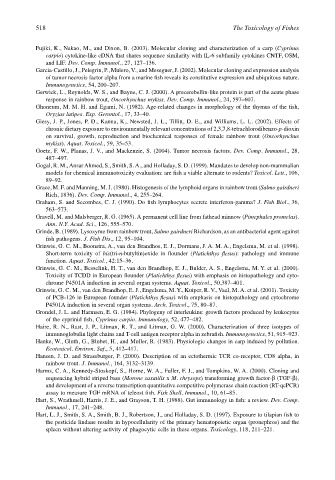Page 538 - The Toxicology of Fishes
P. 538
518 The Toxicology of Fishes
Fujiki, K., Nakao, M., and Dixon, B. (2003). Molecular cloning and characterization of a carp (Cyprinus
carpio) cytokine-like cDNA that shares sequence similarity with IL-6 subfamily cytokines CNTF, OSM,
and LIF. Dev. Comp. Immunol., 27, 127–136.
Garcia-Castillo, J., Pelegrin, P., Mulero, V., and Meseguer, J. (2002). Molecular cloning and expression analysis
of tumor necrosis factor alpha from a marine fish reveals its constitutive expression and ubiquitous nature.
Immunogenetics, 54, 200–207.
Gerwick, L., Reynolds, W. S., and Bayne, C. J. (2000). A precerebellin-like protein is part of the acute phase
response in rainbow trout, Oncorhynchus mykiss. Dev. Comp. Immunol., 24, 597–607.
Ghoneum, M. M. H. and Egami, N. (1982). Age-related changes in morphology of the thymus of the fish,
Oryzias latipes. Exp. Gerontol., 17, 33–40.
Giesy, J. P., Jones, P. D., Kanna, K., Newsted, J. L., Tillitt, D. E., and Williams, L. L. (2002). Effects of
chronic dietary exposure to environmentally relevant concentrations of 2,3,7,8-tetrachlorodibenzo-p-dioxin
on survival, growth, reproduction and biochemical responses of female rainbow trout (Oncorhynchus
mykiss). Aquat. Toxicol., 59, 35–53.
Goetz, F. W., Planas, J. V., and Mackenzie, S. (2004). Tumor necrosis factors. Dev. Comp. Immunol., 28,
487–497.
Gogal, R. M., Ansar Ahmed, S., Smith, S. A., and Holladay, S. D. (1999). Mandates to develop non-mammalian
models for chemical immunotoxicity evaluation: are fish a viable alternate to rodents? Toxicol. Lett., 106,
89–92.
Grace, M. F. and Manning, M. J. (1980). Histogenesis of the lymphoid organs in rainbow trout (Salmo gairdneri
Rich, 1836). Dev. Comp. Immunol., 4, 255–264.
Graham, S. and Secombes, C. J. (1990). Do fish lymphocytes secrete interferon-gamma? J. Fish Biol., 36,
563–573.
Gravell, M. and Malsberger, R. G. (1965). A permanent cell line from fathead minnow (Pimephales promelas).
Ann. N.Y. Acad. Sci., 126, 555–570.
Grinde, B. (1989). Lysozyme from rainbow trout, Salmo gairdneri Richardson, as an antibacterial agent against
fish pathogens. J. Fish Dis., 12, 95–104.
Grinwis, G. C. M., Boonstra, A., van den Brandhos, E. J., Dormans, J. A. M. A., Engelsma, M. et al. (1998).
Short-term toxicity of bis(tri-n-butyltin)oxide in flounder (Platichthys flesus): pathology and immune
function. Aquat. Toxicol., 42:15–36.
Grinwis, G. C. M., Besselink, H. T., van den Brandhop, E. J., Bulder, A. S., Engelsma, M. Y. et al. (2000).
Toxicity of TCDD in European flounder (Platichthys flesus) with emphasis on histopathology and cyto-
chrome P4501A induction in several organ systems. Aquat. Toxicol., 50,387–401.
Grinwis, G. C. M., van den Brandhop, E. J., Engelsma, M. Y., Kuiper, R. V., Vaal, M. A. et al. (2001). Toxicity
of PCB-126 in European founder (Platichthys flesus) with emphasis on histopathology and cytochrome
P4501A induction in several organ systems. Arch. Toxicol., 75, 80–87.
Grondel, J. L. and Harmsen, E. G. (1984). Phylogeny of interleukins: growth factors produced by leukocytes
of the cyprinid fish, Cyprinus carpio. Immunology, 52, 477–482.
Haire, R. N., Rast, J. P., Litman, R. T., and Litman, G. W. (2000). Characterization of three isotypes of
immunoglobulin light chains and T-cell antigen receptor alpha in zebrafish. Immunogenetics, 51, 915–923.
Hanke, W., Gluth, G., Blubet, H., and Muller, R. (1983). Physiologic changes in carp induced by pollution.
Ecotoxicol. Environ. Saf., 5, 412–417.
Hansen, J. D. and Strassburger, P. (2000). Description of an ectothermic TCR co-receptor, CD8 alpha, in
rainbow trout. J. Immunol., 164, 3132–3139.
Harms, C. A., Kennedy-Stoskopf, S., Horne, W. A., Fuller, F. J., and Tompkins, W. A. (2000). Cloning and
sequencing hybrid striped bass (Morone saxatilis x M. chrysops) transforming growth factor-β (TGF-β),
and development of a reverse transcription quantitative competitive polymerase chain reaction (RT-qcPCR)
assay to measure TGF mRNA of teleost fish. Fish Shell. Immunol., 10, 61–85.
Hart, S., Wrathmell, Harris, J. E., and Grayson, T. H. (1988). Gut immunology in fish: a review. Dev. Comp.
Immunol., 17, 241–248.
Hart, L. J., Smith, S. A., Smith, B. J., Robertson, J., and Holladay, S. D. (1997). Exposure to tilapian fish to
the pesticide lindane results in hypocellularity of the primary hematopoietic organ (pronephros) and the
spleen without altering activity of phagocytic cells in these organs. Toxicology, 118, 211–221.

